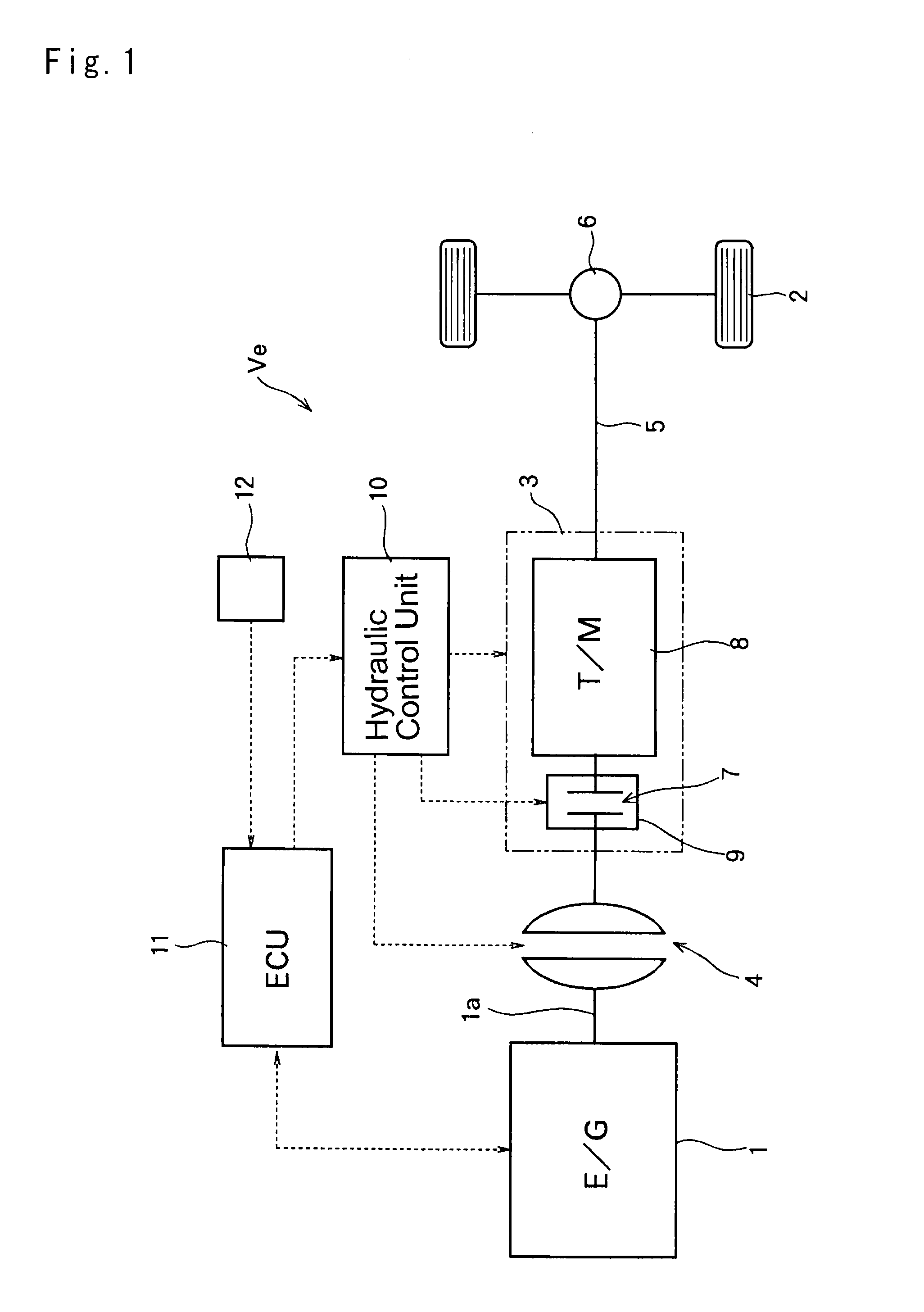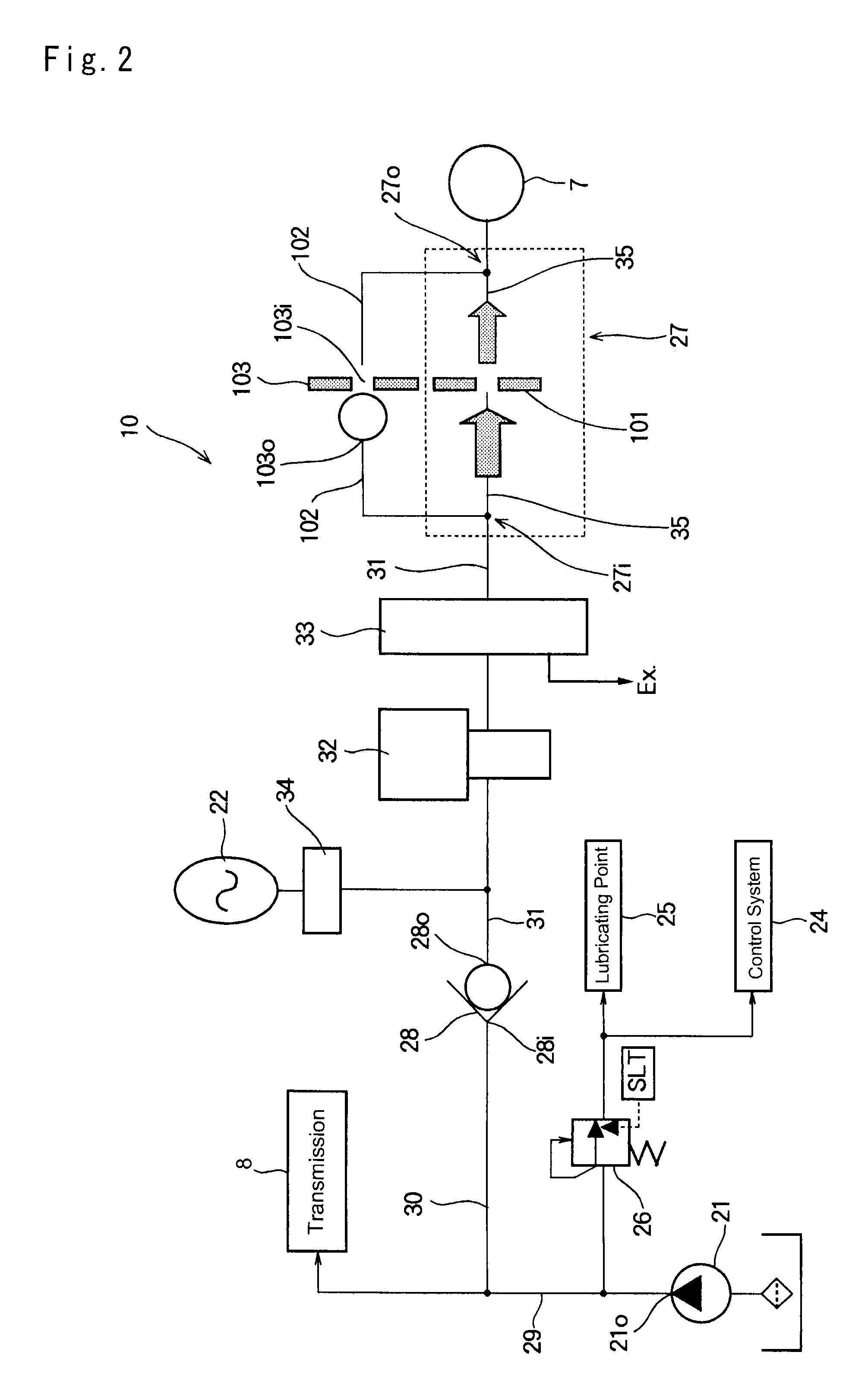Hydraulic control system for vehicle
a control system and hydraulic technology, applied in the direction of machines/engines, engine starters, transportation and packaging, etc., can solve the problems of inability to smoothly return the hydraulic pressure to the forward clutch, the drive position cannot be smoothly shifted from the d position to the n position, and the inability to actuate the hydraulic pressure of the forward clutch, etc., to achieve the effect of quick disengagement, and improving the hydraulic response of the clutch devi
- Summary
- Abstract
- Description
- Claims
- Application Information
AI Technical Summary
Benefits of technology
Problems solved by technology
Method used
Image
Examples
first example
[0052]According to the first example illustrated in FIG. 3, the hydraulic circuit 27 is comprised of a passage 37 on which an orifice 36 is formed, a passage 39 on which an orifice 38 is formed, and a change valve 40 adapted to selectively provide a connection between the passage 37 and the passage 31 and between the passage and the passage 31. Those passages 37 and 39 are arranged parallel to each other between the passage 31 on which the clutch control valve 32 and the manual valve 33 are disposed and the passage 35 connected to the clutch device 7, and both leading ends of the passages 37 and 39 of the clutch device 7 side are connected to the passage 35. Leading ends of the passages 37 and 39 of the other side are connected to the passage 31 through the change valve 40.
[0053]A structure of the orifice 36 is similar to that of the aforementioned conventional orifice 101, and a diameter of the orifice 36 is optimized to suppress hydraulic vibrations and pulses caused by the clutch...
second example
[0059]According to the second example illustrated in FIG. 4, the hydraulic circuit 27 is comprised of a passage 42 on which an orifice 41 is formed, and a passage 45 on which an on-off valve 43 is disposed and an orifice 44 is formed. Those passages 42 and 45 are arranged parallel to each other between the passage 31 on which the clutch control valve 32 and the manual valve 33 are disposed and the passage 35 connected to the clutch device 7, and both leading ends of the passages 42 and 45 of the manual valve 33 side are connected to the passage 31. Leading ends of the passages 42 and 45 of the clutch device 7 side are connected to the passage 35.
[0060]A structure of the orifice 41 is also similar to that of the aforementioned conventional orifice 101, and a diameter of the orifice 41 is optimized to suppress hydraulic vibrations and pulses caused by the clutch control valve 32. On the other hand, a diameter of the orifice 44 is optimized to ensure sufficient flow rate of the fluid f...
third example
[0067]According to the third example illustrated in FIG. 5, the hydraulic circuit 27 is comprised of a passage 47 on which an orifice 46 is formed, and a passage 50 on which a solenoid valve 48 is disposed and an orifice 49 is formed. Those passages 47 and 50 are arranged parallel to each other between the passage 31 on which the clutch control valve 32 and the manual valve 33 are disposed and the passage 35 connected to the clutch device 7, and both leading ends of the passages 47 and 50 of the manual valve 33 side are connected to the passage 31. Leading ends of the passages 47 and 50 of the clutch device 7 side are connected to the passage 35. In addition, a pressure gauge 51 is disposed on the passage 35 to measure pressure of the fluid to engage the clutch device 7.
[0068]A structure of the orifice 46 is also similar to that of the aforementioned conventional orifice 101, and a diameter of the orifice 46 is optimized to suppress hydraulic vibrations and pulses caused by the clut...
PUM
 Login to View More
Login to View More Abstract
Description
Claims
Application Information
 Login to View More
Login to View More - R&D
- Intellectual Property
- Life Sciences
- Materials
- Tech Scout
- Unparalleled Data Quality
- Higher Quality Content
- 60% Fewer Hallucinations
Browse by: Latest US Patents, China's latest patents, Technical Efficacy Thesaurus, Application Domain, Technology Topic, Popular Technical Reports.
© 2025 PatSnap. All rights reserved.Legal|Privacy policy|Modern Slavery Act Transparency Statement|Sitemap|About US| Contact US: help@patsnap.com



